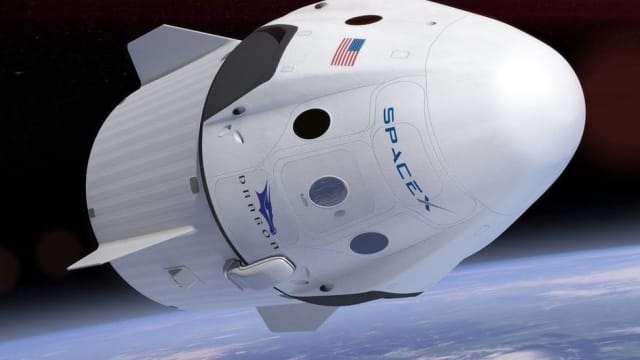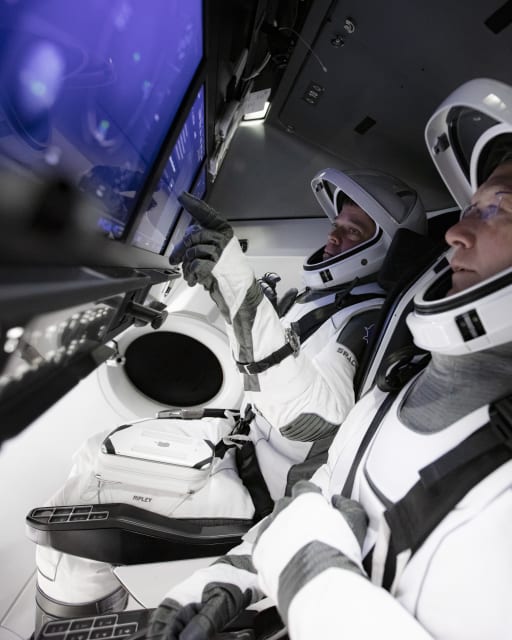
We’ve entered a new era of spaceflight—and the SpaceX Crew Dragon has blown the door open as the first privately built spacecraft to carry astronauts into orbit. The May 30 launch of the spacecraft, atop a SpaceX Falcon 9, was the first U.S. crewed space mission to launch from American soil since 2011.
The Dragon, which is currently docked at the International Space Station (ISS), can carry up to seven passengers and plenty of cargo into space. It is 26.7 feet long with a diameter of 13 feet, and has a launch payload mass of up to 13,228 pounds and a return mass of 6,614 pounds.
Inside the Crew Dragon on its way to the ISS.
The spacecraft is powered by 16 Draco thrusters that allow it to perform maneuvers such as apogee/perigee maneuvers, orbit adjustment and attitude control. Each Draco can generate 90 pounds of force in the vacuum of space. The vehicle also comes equipped with 8 SuperDracos capable of 16,400 pounds of force. These engines form a part of a launch escape system that would rapidly separate the Dragon from the rocket in an emergency—carrying the astronauts a half mile away from the rocket in less than eight seconds.
The Dragon is completely autonomous—though the crew are able to take over manual control of the aircraft to pilot it when necessary. The vehicle is designed to be able to navigate on its own for the entirety of its mission; in fact, the Dragon’s autopilot has already seen repeated use in SpaceX’s cargo missions to the ISS. NASA astronauts Bob Behnken and Doug Hurley, both experienced space shuttle pilots, tested the manual override on their way to the station—the first time the manual controls were put to use in space.

The Dragon also features a much different crew interface than the switches and buttons of earlier era spacecraft, opting for a touchscreen instead—one that can be controlled by crew members wearing spacesuit gloves. Using a touchscreen required the astronauts to retrain their minds and reactions to get used to the radically different interface—to process a visual cue rather than physically flip a switch. “There’s a mode you can turn on where you can see the touch, so that when you put your finger on the screen, it blooms or it flares—which is extremely helpful when you’re wearing gloves and you might not know if you’ve actually touched it,” said Behnken, who along with Hurley worked closely with SpaceX to develop the spacecraft’s controls.
There were notable differences from a space shuttle trip, according to the astronauts. “We were surprised a little bit at how smooth things were off the pad,” said Behnken. He credited the easy liftoff to the Falcon 9’s liquid-fuelled rocket, which allowed the Dragon to get off the ground much more smoothly than the old space shuttle’s solid rocket boosters.
But once the Dragon gained altitude, the ride got a little bumpier. “Dragon was huffing and puffing all the way into orbit,” Behnken continued. “It was not quite the same ride, the smooth ride, as the space shuttle was up to MECO [main engine cutoff]—a little bit less G’s but a little bit more alive is probably the best way I would describe it.”
There was also a noticeable delay in the transition from first to second stage. “The first stage engine shut off—and then it takes a second, almost a second, might have been less than that—but it seemed like it took some time between the booster separating and then the Merlin vacuum engine starting,” said Hurley. “At that point, we go from roughly three Gs to zero Gs for, I don’t know, half a second probably. And then when that Merlin vacuum engine fires, then we start accelerating again for the next five, six minutes until we achieve orbit … it’ll be interesting to talk to the SpaceX folks to find out why it was a little bit rougher ride on second stage than it was for shuttle.”

The Dragon did dock with the ISS without a bump—so much so that the astronauts barely noticed when docking was complete. “We didn’t feel the docking; it was just so smooth,” said Hurley. “In shuttle, you felt a little bit of a jolt.”
NASA anticipates that Behnken and Hurley will fly the Dragon back home as early as the end of July—the next significant test of the spacecraft, which has performed as promised so far.
A successfully completed Dragon mission will open the door to a regular rotation of crewed flights to the ISS—something NASA hasn’t seen since the days of the space shuttle. And the agency is already planning the next Dragon flight, which will carry four astronauts into space.
Though the mission isn’t finished yet, it has already made spaceflight history and is opening up the possibilities of commercial space travel.
“When we got that hatch open, you could tell it was a brand-new vehicle … just as if you had bought a new car,” said astronaut Chris Cassidy, who was aboard the ISS to welcome the Dragon and its crew.
Read more about the Dragon’s path to launch at SpaceX Gets Ready to Put Humans Into Space.
https://news.google.com/__i/rss/rd/articles/CBMiggFodHRwczovL3d3dy5lbmdpbmVlcmluZy5jb20vQWR2YW5jZWRNYW51ZmFjdHVyaW5nL0FydGljbGVJRC8yMDM1NS9UaGUtU3BhY2VYLUNyZXctRHJhZ29uLVRoaXMtQWludC1Zb3VyLVBhcmVudHMtU3BhY2UtU2h1dHRsZS5hc3B40gEtaHR0cHM6Ly9tb2JpbGUuZW5naW5lZXJpbmcuY29tL2FtcC8yMDM1NS5odG1s?oc=5
2020-06-15 16:42:46Z
CAIiEJ-gFkpOtCHgpRsFI-7boikqGQgEKhAIACoHCAow85bwCjDw07cCMIb_hgM
Tidak ada komentar:
Posting Komentar